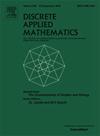On partitioning a bipartite graph into cycles and degenerated cycles
IF 1
3区 数学
Q3 MATHEMATICS, APPLIED
引用次数: 0
Abstract
For a bipartite graph , let be the minimum degree sum of two non-adjacent vertices in different partite sets of . We prove the following result: If is a balanced bipartite graph of order , and if , then one of the following (i)–(iv) holds: (i) contains vertex-disjoint subgraphs such that and for each , , is a cycle or or ; (ii) and ; (iii) and ; (iv) and . This result is a bipartite graph version of the result of Enomoto and Li (2004). We actually prove a stronger result which gives us control on the number of cycles in the vertex-disjoint subgraphs of (i).
二部图的环与退化环的划分
对于二部图G,设σ1,1(G)是G的不同部集中两个不相邻顶点的最小度和,证明了以下结果:如果G是2n≥k阶的平衡二部图,且σ1,1(G)≥n−(k−1)/2+1,则下列(i) - (iv)之一成立:(i) G包含k个顶点不相交的子图H1,…,Hk,使得∈1≤i≤kV(Hi)=V(G),且对于每一个i, 1≤i≤k, Hi是一个循环或K1或K2;(ii) G = C6, k=2;(iii) G = C8, k=2,3;(iv) G = C10, k=4。这个结果是Enomoto和Li(2004)的结果的二部图版本。实际上,我们证明了一个更强的结果,它使我们能够控制(i)的k个顶点不相交子图中的循环数。
本文章由计算机程序翻译,如有差异,请以英文原文为准。
求助全文
约1分钟内获得全文
求助全文
来源期刊

Discrete Applied Mathematics
数学-应用数学
CiteScore
2.30
自引率
9.10%
发文量
422
审稿时长
4.5 months
期刊介绍:
The aim of Discrete Applied Mathematics is to bring together research papers in different areas of algorithmic and applicable discrete mathematics as well as applications of combinatorial mathematics to informatics and various areas of science and technology. Contributions presented to the journal can be research papers, short notes, surveys, and possibly research problems. The "Communications" section will be devoted to the fastest possible publication of recent research results that are checked and recommended for publication by a member of the Editorial Board. The journal will also publish a limited number of book announcements as well as proceedings of conferences. These proceedings will be fully refereed and adhere to the normal standards of the journal.
Potential authors are advised to view the journal and the open calls-for-papers of special issues before submitting their manuscripts. Only high-quality, original work that is within the scope of the journal or the targeted special issue will be considered.
 求助内容:
求助内容: 应助结果提醒方式:
应助结果提醒方式:


